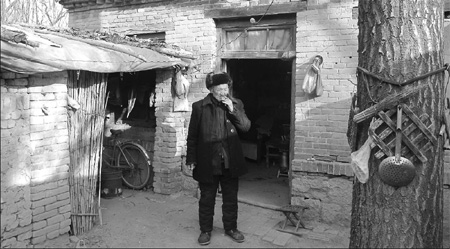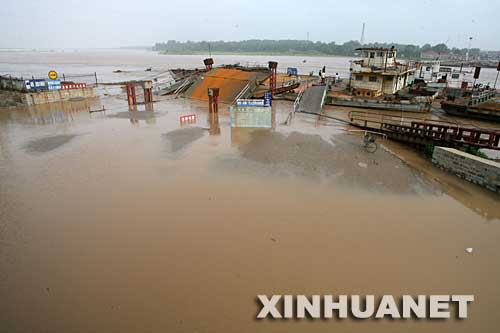Floods of tears
Villagers on the banks of the Yellow River live in fear of floods while government relocation plans are dogged by delays.
Cheng Yueming, 77, has lived through four major floods in his lifetime. Each time his home has been destroyed, each time he has been forced to rebuild on the ruins.
The villager is one of thousands in Shandong and Henan provinces living on the lower reaches of the Yellow River desperately waiting to be relocated from the floodplains to higher ground, as promised by local authorities. His hopes have been raised many times, only to be dashed time and again, said Cheng.
 |
|
Cheng Yueming, 77, of Huaerzhuang village in Shandong province has had to rebuild his home after it was destroyed when the Yellow River burst its banks, flooding the area. [China Daily] |
"The first time we heard we were all to be relocated was in 1958, which was the year the floodwaters were so high I had to stand on my roof to stay safe," he said as he smoked a cigarette in his one-room, soil-walled house in Huaerzhuang village, close to the capital of Jinan.
Other than in 1958, floods also devastated the area in 1949, 1976 and 1996.
"I built my current house brick by brick with my own hands on top of the house that was ruined in 1996," said Cheng. "In August that year, I woke up to find tables floating next to my bed. I got up and boated around the village to help other villagers. Every time, the floodwaters crush my house."
In 1976 Cheng made the heartbreaking decision to allow a relative living far from the floodplains to adopt his youngest son. He said the burden of rebuilding his home once again was too much for his annual income of 400 yuan ($60). His two eldest sons have since left in search of better opportunities in Northeast China.
About 2,000 villages lie within levees of the Yellow River, a waterway that has altered course many times throughout history. Huaerzhuang, a sprawl of red brick, thatched houses, is just 500 m from the river's banks and enjoys little protection. "Living in my house, I feel little sense of security," said Li Yanqin, 65, of Huaerzhuang, whose home has also been repeatedly damaged by flooding.
The relocation plans have been dogged by delays, say residents, who blamed a dispute between villagers and officials over whether people actually want to move, and wrangles about potential land exchange and compensation packages.
Huaerzhuang was last slated for relocation in 1998 during the first of two major resettlement projects run jointly by the Shandong Development and Reform Commission, the construction department of Jinan government and the Yellow River Conservancy Commission. The second was in 2003.
"In 1998, leaders of the town and county governments were stationed in Zhumaodian, the village behind the levee where we were expected to move to, and had even mapped out the land assigned to us," said Cheng Chuanmin, village chief for Huaerzhuang. "But in the end nothing happened and the leaders just left."
 |
|
The biggest flood since 1997 in the Yellow River's Shandong section.[File photo] |
According to Chen Yong, a spokesman for the administering Cuizhai town government, the villagers have not yet been relocated because "some are unwilling to move". However, his statement puzzled residents in Huaerzhuang, many of whom told China Daily they had never once been asked for their opinion.
Chen also said other villages had been reluctant to exchange land with Huaerzhuang because it has no collective land outside the levee. This was also met with suspicion, this time in Zhumaodian, where residents said they would be happy to share their land as long as they receive compensation from local authorities. "The land around Huaerzhuang is barren. No one exchanges fertile land for poor land unless they get compensation. Sadly, no officials have talked to any of us about compensation yet," said Sun Jilu, village chief for Zhumaodian.
As part of the plan to move citizens out of floodplain villages, the provincial government pledged to give 3,000 yuan to each registered resident, according to the Yellow River Conservancy Commission's department of planning and programming.
The total budget for the Huaerzhuang relocation is unknown but residents said they were told the Cuizhai government had spent 920,000 yuan on an "emergency exit" road to the levee and 20,000 yuan on repairing the village primary school, as well as put aside more than 90,000 yuan for compensation. But the winning bid by a construction crew from nearby Dongxinzhuang to build the exit road was just 260,000 yuan, according to Liu Yingwu, village chief for Dongxinzhuang. The Jiyang county government and the Shandong Development and Reform Commission declined to comment when contacted by China Daily.
Authorities in Shandong and Henan coordinated both the 1998 and 2003 resettlement projects, said Zhang Junfeng, director of the Yellow River Conservancy Commission's department of planning and programming. Official figures show that, by 2007, more than 110,000 of the 127,300 residents in the provinces' floodplain villages have moved out of the high-risk zones.
The dream is still to become a reality for those in Huaerzhuang, yet official maps of Jinan published since 2001 tell a different story. "We still live within the levee but according to the map we have already moved to a safer place," said villager Cheng Chuangguang, 35. The error was a "simple mistake", said a spokesman for the county government. However, the mistake has also been repeated in the 2009 edition of the official Shandong Atlas.
Almost 1.9 million people live in dangerous floodplain zones across China, said experts, and like most places, the majority of Huaerzhuang's young have migrated to cities for better paying jobs. In a village with a registered population of 228, only about 100 women, children and elderly people remain.
"When floods come, villages on the floodplains become solitary islands. As young people move away for work, those left behind are vulnerable," said Cheng Xiaotao, a professor and researcher in water hazards with the China Institute of Water Resources and Hydropower Research in Beijing. "But it's a complicated issue and situations vary drastically from village to village. Not every village needs to be moved."
To guard against flood damage, many villagers build their homes on a platform of soil to raise their property about 4 m higher than the Yellow River's level. The technique, however, has been largely ineffective.
"In heavy rainfall, the soil bases sag and the houses sink," said Cheng Chuanmin, village chief for Huaerzhuang, as he pointed to a large crack stretching down the back wall of a house in the east of the village. House repairs can cost up to three times the average annual income of a countryside family - about 1,000 yuan - while heavy rain also destroys crops, he said.
Residents strengthen the levee every spring without financial support from the local authorities, villagers said.
Since 2005, the central and local governments have been working on a new compensation package, and last year the Yellow River Conservancy Commission proposed a comprehensive management schedule and flood protection program to the Ministry of Water Resources, said commission official Zhang Junfeng. The program will involve almost 500 villages within 1 km of the banks of the Yellow River, with more than 800,000 residents benefiting from solid, waterproof house bases and at least 300 villages getting new emergency exit roads.
Huaerzhuang is included in the project, although the plan may need to be adjusted in practice, said Zhao Yinhai, of the commission's planning and programming department.
Zhang added that the biggest issue in the floodplain move lies with land distribution, which is still a "great obstacle."
"I have called and written scores of times to the county, municipal and provincial governments, and even to the Yellow River Conservancy Commission to ask when we can expect to move. I have received only two replies since 2008," said villager Cheng Chuanguang. "The people here are holding onto the dream but fear being disappointed again."
 0
0 







Go to Forum >>0 Comments